
Entropic Systems Biology: a Novel Thermodynamic Theory for the Modernization of Traditional Chinese Medicine
*Corresponding Author(s):
Zilin NieDepartment Of Infectious Diseases, Mayo Clinic, Rochester, United States
Tel:+1 5072734012,
Email:nie.zilin@mayo.edu
Yanming Nie
College Of Information Engineering, Northwest A & F University, Yangling, Shaanxi, China
Tel:+86 13572917517,
Email:yanmingnie@nwafu.edu.cn
Abstract
As a complementary and alternative medicine in the western countries for decades, Traditional Chinese Medicine (TCM) has been used for more than 2000 years in China. Because of the characteristics of the philosophical style and the unknown mechanism of action, TCM sometimes has been biasedly described as "fraught with pseudoscience". From the scientific basis of the systems biology, here we promoted a novel medical model called the entropic systems medicine which could be applied to scientize TCM in future. In entropic systems medicine, TCM and Western modern biomedicine target the different variables of the entropic system. For instance, while Western modern biomedicine directly targets the phenotypes and its SOCs of macrostates, TCM differently targets the microstates, entropy and entropic force to generate SOTFs gradually causing the differentiated syndromes to be slowly rearranged. The prerequisites to modernize TCM are the entropic systems biology having been well established so that the variables could be precisely monitored and mathematically calculated.
Keywords
Acupuncture points; Aquamoleculomics; Chinese herbs; Complementary and alternative medicine; Entropic systems biology; Meridians (Jingluo); Traditional Chinese Medicine (TCM); Thermodynamic mechanism; Self-Organized Criticality (SOC); Self-Organization Triggering Factor (SOTF); Wuxing (five phases), Qi, Modernization of TCM
Introduction
Traditional Chinese medicine (TCM) has been practiced in the Sinosphere for more than 2000 years. Unlike Western modern sciences and biomedicines, the theoretical system and practice of TCM are philosophically described as qi, yin-yang, wuxing and analogies from microcosm-macrocosm. Nonetheless, TCM contributed the critical roles for the healthcare system to treat and prevent the diseases in the Sinosphere’s society. Presently, TCM has been a complementary or an alternative medical system in many Western countries [1]. To promote the acceptances in the worldwide, China government initiated the program to modernize TCM theoretical system and clinical practice through the combination with biological science and biomedicine [2-7].
Differently from biological science and biomedicine, qi, wuxing, jing-luo (meridian) and acupuncture point in TCM are not developed in the approach of the evidence-based medicine. For the reason, TCM has been biasedly described as "fraught with pseudoscience” sometimes both in China and in the Western world since the concepts in TCM are not well demonstrated with the measurable effectiveness and the logical mechanism of action [2]. To meet the requirements for the Western science and biomedicine, in the early of this century Chinese government initiated a magnificent program to globalize and modernize TCM. After jumping on the bandwagon of the systems biology, the knowledge and the therapeutic regimes were biologically updated in the concepts of omics, specifically in syndrome differentiation and acupuncture [8-9].
Apparently, the globalization and the wide acceptation of TCM in Western world are not accomplished after decades of the movement of the good practice in the scientific community. In this article, we promote an alternative theoretic model, entropic systems medicine, to simultaneously modernize TCM and current biomedicines the combination into the entire system of the integrated medicine.
Wuxing And Entropic System Variables
Living organisms including human body are the semi-open nonlinear thermodynamic systems far from equilibrium. In general opinion, the biomedicine in the Western countries mainly focuses on the specific structures and functions of the system, while TCM focuses on the entire structures and functions of the body. In fact, the concepts of the structures such as molecules are extinguishable in the biological system and in the thermodynamic system, in which the molecules are not defined by the specific atoms and its composition sequences such as amino acids and nucleotides or proteins and DNAs. Thermodynamic mechanism is determined by five basic variables including microstate (Ω), macrostate (ΔX), free energy (Q), entropic force (FΔX) and entropy (S), which interact each other by following the law of entropic system. The entropy laws are thought to be placed at the highest position in the universe, which coincidentally meets the Wuxing of the ancient Chinese philosophy. Wuxing is also called "five phases" or perhaps five functional systems including water, earth (or soil), fire, metal (or gold) and tree (or wood), each of which functionally represents one of the five variables respectively in the entropic system. In the entropic system, water could be ordered as Ω, earth could be ordered as ΔX, fire could be ordered as Q, metal could be ordered as FΔX, and tree could be ordered as S, then we could have [10]: 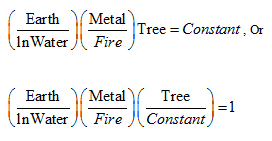
In this hypothesized context, the law of the entropic system is the scientific basis of the five phases in Wuxing.
Qi, Meridians And Acupuncture Points In Entropic System
Qi, meridians and acupuncture points are primarily responsible for TCM being accused of pseudoscience because of no scientific evidence based. To date, it is true that Qi, meridians and acupuncture points are still undetectable experimentally just as spirit mind. However, the modern bioscience including molecular biology and systems biology also fails to fully interpret many phenotypes in our body, especially psychiatric activities theoretically and/or experimentally. Indeed, it is impossible to explore all issues in the phenomenological sciences. To fundamentally expend the current bioscience, we hypothetically promoted the novel model of the entropic systems biology in which all living organisms are composed of the layers of the entropic systems in a hierarchical complexity manner. It is believable that free energy and entropic force (function as Qi) are essential to drive all biological and spiritual processes (body) under the guidance of the entropy and the entropic system constant (function as spirit) (Figure1) [10].

Figure 1: The schematic depiction for the body (material), Qi (energy) and spirit (information) in the entropic system and the Wuxing system.
The self-organization of the entropic systems might be the essential mechanism for the evolution of the universe. The most significant difference between the living systems and the nonliving systems are the formation of the Self-Organized Criticalities (SOCs) and the production of the Self-Organization Triggering Factors (SOTFs) [10]. In the nonliving systems such as the sand piling model, the last drop of sand (SOTF) could cause the sand piling collapse leading the passive rearrangement of the macrostates [11]. In the revolution of the living systems, the continuous SOCs are formed through the power distribution and the metabolism of the bimolecular. The living systems will stay the rest phases without the stimulations from the SOTFs. After receiving the intra and/or extra SOTFs, the SOCs will be activated resulting in series of the responses including the changes of the phenotypes and even the replications of the organisms. In our human body, there are some specific anatomic sites with the special SOCs functioning as the acupuncture points, in which SOTFs could be profoundly generated when stimulated by the acupunctures and so on. In these cases, the entropic forces formed in the acupunctures could distantly act on the other phenotypes (macrostates) of our body via the vector pipelines (meridians or Jingluo) of the energy and/or information in the model of hierarchical complexities.
Aqua Molecule Complexes And Traditional Chinese Herbs
It is undeniable that the therapeutically effects of Traditional Chinese herbs (TCHs) occur in the certain diseases especially in the chronic diseases. However, TCH therapy is usually not considered as the good practice since the non-evidence based and the unknown active ingredients. Therefore, it is emergent for researches and the practitioners in TCM society to develop the modern theoretical and experimental models so that the mechanism of the actions and the active ingredients in TCH therapy could be properly interpreted. Thermodynamic aquamoleculomics, a novel theoretical model of systems biology we promoted, could be a candidate to accomplish the tasks [12]. In Thermodynamic aquamoleculomics theory, we hypothesized that the putative aquamoleculosome (aqua molecule complex) could be an essential unit for the biological structures, the biological energy and the biological information in human body. Water is the mother of life, occupying 70-95% compositions in the organisms. In human body, every molecule is protected and identified by H2O networks. In TCH therapy, H2O networks could introduce aquamoleculosomeB with high free energy of H2O clusters from herb soups of TCH to recognize aquamoleculosomeA with low free energy of H2O clusters. If each aquamoleculosome was considered as an entropic system, the entropic variables including matter, energy and information in aquamoleculosome B and A would be fused into aquamoleculosome AB through the thermodynamic mechanism as shown in figure 2. It could be the mechanism of TCH action through the changes of the microenvironment (microstates) to generate 1/f noise of the spectral entropy [12]. 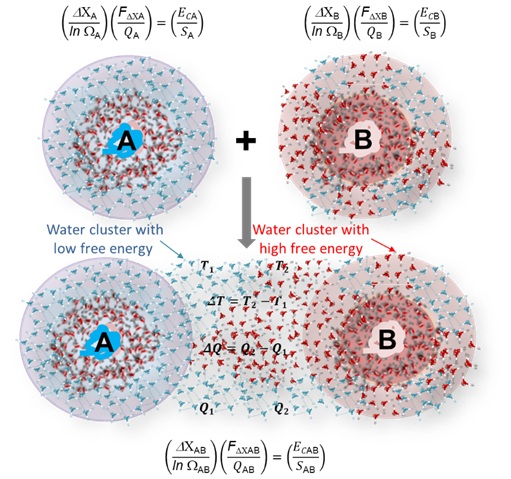
Figure 2: The schematic depiction for the thermodynamic interaction between the aqua molecule complexes A in the body and the aqua molecule complexes B from the water soups of the Herb mixtures.
Traditional Chinese Herbs (TCHs) are sorts of the mixing soups of water molecules and biomolecules, in which the aquamolecule complexes or the aquamoleculosomes could change the microstates and the entropy of the local entropic systems creating certain SOTFs to cause the pathological SOCs slowly to be rearranged. In this model of the mechanism, it is possible that the TCHs could cure the chronic diseases and/or could improve the progression of the various diseases.
Theoretical Rational Of Bian Zheng LunZhi In Entropic Systems Medicine
TCM is a kind of medicine with the philosophical theories and methods. Generally, the concept of the diseases in TCM is the imbalances in Qi, Ying-Yang and the functional systems (zàng)of human body such as kidney, spleen, heart, lung, liver, and so on, which are similar to the imbalance too far from equilibrium in the thermodynamic systems. In wuxing theory, five zàngsuch as kidney, spleen, heart, lung and liverare corresponded to water, earth, fire, metal and tree. From the hypothetical equation (1), we could have:
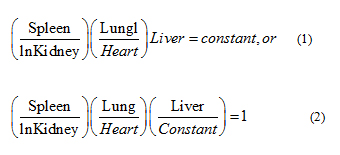 In the equation (2), the body constant represents the personality and the health hallmark of the individuals. From the Wuxing, five zàng and the entropic equations, we also could have a schematic carton of wuxing, five zàng and the entropic system of human body to depict the interactions of the variables in the entropic systems medicine (Figure 3).
In the equation (2), the body constant represents the personality and the health hallmark of the individuals. From the Wuxing, five zàng and the entropic equations, we also could have a schematic carton of wuxing, five zàng and the entropic system of human body to depict the interactions of the variables in the entropic systems medicine (Figure 3).
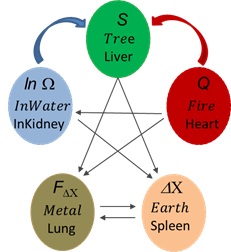 Figure 3: The schematic depiction for the hypothesized correspondent relationship of the entropic system, zang system and the Wuxing system.
Figure 3: The schematic depiction for the hypothesized correspondent relationship of the entropic system, zang system and the Wuxing system.
The equation (2) could be also derived as followings:
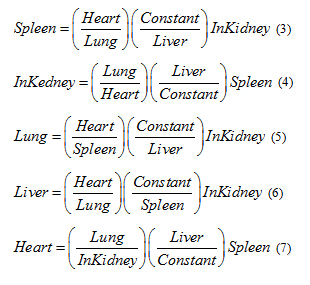 In TCM, the imbalances of the functional units are described as the syndromes, which are likely corresponded to QR code-like patterns. The diagnosis in TCM is called the syndrome (a pathological macrostate SOC of the entropic system) differentiations just as QR code scanning, e.g., the identifications of the spirit states, the pulse patterns and the tongue coatings via looking through or asking, finger touching, and so on [13]. The treatment in TCM is philosophically complementary principles based on the symmetry of the Ying-Yang, or the super symmetry of the wuxing interacting cycle [14]. Therefore, the scientific rational of TCM could be considered as the same as the law of the entropic system in the thermodynamic mechanism. The patterns of the syndromes in TCM could be equally to the temperature and the pressure in the thermodynamic container, which are equal to the macrostates of the entropic system. It is true that the mechanism is not known for the most syndromes. However, the two major syndrome differentiations, the pulse patterns and the tongue coatings probably reflect the heart driven convention and the body’s chemical reaction oscillation. It is known that the dissipative structures could be generated in Rayleigh-Bénard convection and B-Z chemical reaction oscillation [15,16]. The convention and the oscillation are thought as the key processes to create the biological time and space.
In TCM, the imbalances of the functional units are described as the syndromes, which are likely corresponded to QR code-like patterns. The diagnosis in TCM is called the syndrome (a pathological macrostate SOC of the entropic system) differentiations just as QR code scanning, e.g., the identifications of the spirit states, the pulse patterns and the tongue coatings via looking through or asking, finger touching, and so on [13]. The treatment in TCM is philosophically complementary principles based on the symmetry of the Ying-Yang, or the super symmetry of the wuxing interacting cycle [14]. Therefore, the scientific rational of TCM could be considered as the same as the law of the entropic system in the thermodynamic mechanism. The patterns of the syndromes in TCM could be equally to the temperature and the pressure in the thermodynamic container, which are equal to the macrostates of the entropic system. It is true that the mechanism is not known for the most syndromes. However, the two major syndrome differentiations, the pulse patterns and the tongue coatings probably reflect the heart driven convention and the body’s chemical reaction oscillation. It is known that the dissipative structures could be generated in Rayleigh-Bénard convection and B-Z chemical reaction oscillation [15,16]. The convention and the oscillation are thought as the key processes to create the biological time and space.
Discussion
As an essential property of a thermodynamic system, entropy has been tightly related to the origin and evolution of life for a long period of time. In 1944, Nobel-laureate physicist Erwin Schrödinger published his book: "What Is Life? The Physical Aspect of the Living Cell" and promoted the concept of negentropy to explain the phenomena of the living organism through exporting entropy to the environment to keep its own structures at a high level of orders [17]. More than a century later, there still is no final answer to what life is philosophically or/and biologically. Distinguished from the biological science and biomedicine, TCM belongs to a kind of the philosophy of biological sciences but not based upon the current scientific knowledge with almost no scientific evidences. It is possible that TCM could be the highest of the biomedicine if modernized with the advanced biology such as the systems biology and the good practice of translational medicine. It seems that the systems biology could be able to put the pieces of the evidences together to assembly the entire scenario of the biological phenomena. However, the present data from molecular biology, cell biology and post genomic biology is far not enough for us to translate TCM into the biological science. For example, the biological sciences including systems biology are unable to differentiate living systems and nonliving systems. Further, current biology is also unable to define and measure the conscious minds which might be widely distributed in living organisms. In fact, in the modern bioscience and biomedicine, there are so many pitfalls such as too low reproducibility both in the experimental biology and the translational medicine [18]. Thus, it is extremely irresponsible to allow some biologists or self-proclaimed philosophers to conclude TCM is pseudoscience. In other words, TCM might be the best option at the time when the modern bioscience was not emergent in the models of the thermodynamic mechanism. Of course, there is no question that it is necessary for TCM to be modernized both in scientific theories and clinical practices, not only because of the development of science and technology, but also the revolution of the natural environment and human body.
The entropic systems biology of TCM is a theoretic model based on thermodynamic mechanism, in which the body, Qi and the conscious mind are dynamically balancing each other and coordinating with the natural environment through the communications of matter, energy and information (Figures 1 and 3). In our points of view, both TCM and the current bioscience must be based on thermodynamic mechanisms, to which all living organisms including human beings originally belong. In thermodynamic system, there are only the five basic variables such as microstate, macrostate, free energy, entropic force and entropy, never considering the specific biological molecules such as amino acids, nucleotides, DNAs, RNAs, proteins and even cells. In the entropic system, the five variables are dynamically Inter-promoting and Inter-regulating, exactly as the five phases of wuxing in TCM. The macrostates in the entropic system created from the variable’s integrations could interact via the entropic forces, which function as Qi and meridians in TCM model. The syndrome differentiations in Bian Zheng Lun Zhi are the diagnosis processes to identify the dynamic changes of the tongue coatings and the pulse conditions through inspection, auscultation, olfaction, inquiry, and palpation. The hallmarks of the living thermodynamic systems are the continuous SOCs and SOTFs which govern the physiological self-organizations in the domino chain reaction manner [10]. It is why some local sites of human body could function as the acupuncture points where are more sensitive to generate the SOTFs for the recovery of the non-physiological macrostates. As a dissipative system of human body, all the variables in the entropic system naturally connect with the environment. Therefore, Bian Zheng Lun Zhi in TCM must be more careful in the harmony between human and nature.
From the view of the entropic systems medicine, the differences between TCM and Western modern biomedicine arethe targeted variables. Western modern biomedicine targets SOCs of the phenotypes via the identified SOTFs, directly leading the pathological macrostates to be rearranged in the local entropic systems. TCM differently targets the microstates and entropy to generate SOTFs via the water soups of the mixed herbs or acupuncture and so on, gradually causing the differentiated syndromes of the pathological macrostates to be slowly rearranged through the entropic force and free energy of the entire entropic system (Figure 4).
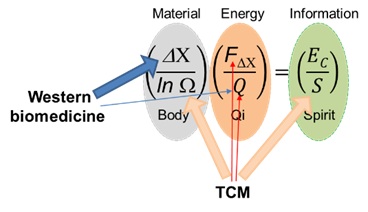
Figure 4: The schematic depiction for the putative mechanisms of the therapeutic effects in Western biomedicine (WBM) and in Traditional Chinese Medicine (TCM).
Based on the hypothetical model of the entropic systems medicine, we could conclude that TCM will meet the Western modern biomedicine in the entropic systems biology and entropic systems medicine. No doubt, the prerequisites are the entropic systems medicine to be well established so that the variables could be precisely monitored and mathematically calculated in future.
Acknowledgement
This work is partially supported by the Basic research program of Natural Science in Shaanxi Province of China (2020JM-173).
References
- Tabish SA (2008) International Journal of Health Sciences. Qassim University 2: 1-143.
- Qiu J (2007) China plans to modernize traditional medicine. Nature 446: 590-591.
- Qiu J (2207) A culture in the balance. Nature 448: 126-128.
- Scheid V (1999) The globalization of Chinese medicine. Lancet 354: 10.
- Wu X, An Y, Yuan M, Wang R (2012) On the Modernization of Traditional Chinese Medicine. Med Aromat Plants 1: 1.
- Qiu J (2015) When the East meets the West: the future of traditional Chinese medicine in the 21st century. National Science Review 2: 377-380.
- Xu ZG (2011) Modernization: One step at a time. Nature 480: 90-92.
- Chen Z, Wang P (2013) Traditional Chinese medicine ZHENG and Omics convergence: a systems approach to post-genomics medicine in a global world. OMICS 17: 451-459.
- Guoa R, Luoa X, Liua J, Liub L, Wangc X, et al. (2020): Omics strategies decipher therapeutic discoveries of traditional Chinesemedicine against different diseases at multiple layers molecular-level (Review). Pharmacological Research 152: 1-11.
- Nie Z, Nie Y (2021) An Equation Simultaneously Encodes the Duality of The Mind and The Body. Preprints 2021: 020233.
- Bak P, Tang C, Wiesenfeld K (1987) Self-organized criticality: an explanation of 1/f noise. Physical Review Letters 59: 381-384.
- Nie Z, Nie Y (2021) Aquamoleculomics: A Thermodynamic Cornerstone of Systems Biology. Preprints 2021: 040686.
- Jiang M, Lu C, Zhang C, Yang J, Tan Y, et al. (2012) Syndrome differentiation in modern research of traditional Chinese medicine. Journal of Ethnopharmacology 140: 634-642.
- Liu W, Lu L, Ma C, Yan C, Zhao Z, et al. (2018) The evolution of Traditional Chinese Medicine as a disciplinaryconcept and its essence throughout history. Traditional Medicine and Modern Medicine 1: 171-180.
- Barzykina I (2020) Chemistry and Mathematics of the Belousov–Zhabotinsky Reaction in a School Laboratory. J Chem Educ 97: 1895-1902.
- Getling AV (1998) Bénard–Rayleigh Convection: Structures and Dynamics. World Scientific.
- Schrödinger E (1944) What Is Life?: The Physical Aspect of the Living Cell.
- Begley CG, Ellis LM (2012) Raise standards for preclinical cancer research. Nature 483: 531-533.
Citation: Nie Z, Nie Y (2021) Entropic Systems Biology: a Novel Thermodynamic Theory for the Modernization of Traditional Chinese Medicine. J Altern Complement Integr Med 7: 171.
Copyright: © 2021 Zilin Nie, et al. This is an open-access article distributed under the terms of the Creative Commons Attribution License, which permits unrestricted use, distribution, and reproduction in any medium, provided the original author and source are credited.

